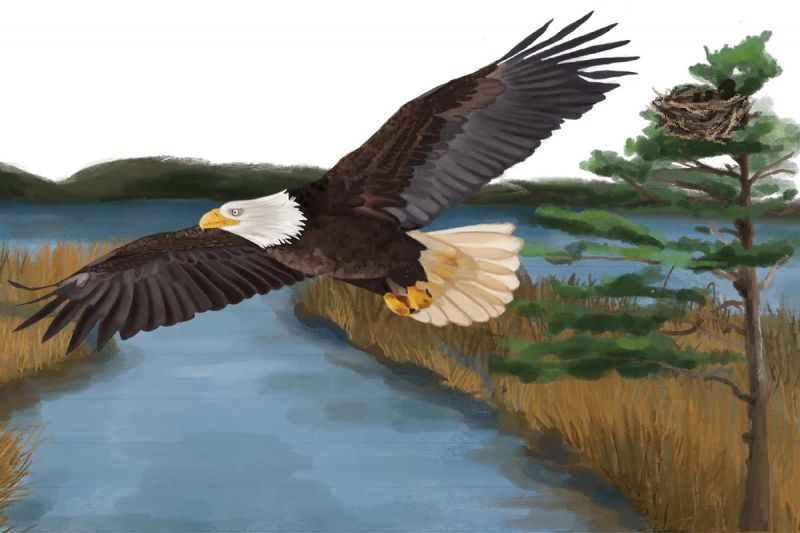And why the raptors like to make their nests in the Lowcountry

This regal raptor is the embodiment of the comeback kid. Distinguished as a national symbol in 1782 but almost driven to extinction in the 1960s from the effects of DDT insecticides, these majestic birds have vigorously rebounded and are no longer on the endangered list. The Lowcountry’s abundance of water and old-growth trees provide an ideal habitat for these birds of prey, also called sea eagles or fish eagles. Take a closer look at the bald eagle, which can be spotted soaring above the Charleston area year-round
BIG BIRD The largest and most powerful bird of prey in the United States, bald eagles boast a wingspan of between five and eight feet and an average weight of about eight pounds (some weigh in at 14 pounds). Females usually are 25 percent larger than males. Because of their enormous size, their nests are the largest of any bird in North America. Erected in old-growth hardwoods near water, they measure an average of four to five feet wide and two to four feet deep. Nests are used year after year until they are destroyed by a storm or collapse from their own weight.
LIFE MATES Bald eagles normally mate for life, though if one mate doens’t return to the next, the remianing eagle will recruit a new partner. Courtship is a high-in-the-sky, aerodynamic affair of swoops, chases, cartwheels, and raucous calls. A pair will even lock talons in a dramatic free fall, only separating right before they reach the ground. October is nest-building and tending time, with the female laying one to two eggs that hatch in late January. Both parents share in incubating and feeding; a young eaglet gains up to six ounces a day, the fastest growth rate of any North American bird. Eaglets fledge in late April. Entirely brown, they do not get their white head until they are five years old. The average life-span in the wild is about 20 years.
NATIONAL TREASURE In June 1782, the Continental Congress adopted the Great Seal of the United States depicting a bald eagle grasping 13 arrows and a 13-leaved olive branch in its talons, referring to the 13 original states. Considered sacred by many Native American cultures, bald eagles figure prominently in numerous religious tribal customs. Laws ensure that feathers used for ceremonial purposes can only be possessed by individuals of Native American ancestry. While no longer considered endangered, the raptors remain on the protected list.
POWER GRAB Their favorite food is fish, caught when the eagle swoops down and snatches its prey from the water with powerful talons. Their diet also includes smaller birds, mammals, amphibians, and even carrion. Projections called “spicules” on the bottom of their feet allow them to tightly grasp prey, holding their dinner in one claw while tearing the flesh with the other. These birds of prey have a gripping power estimated at 10 times greater than humans, and one eagle has been recorded flying with a 15-pound deer fawn in its grasp.
OLD BALDY “Bald” in this instance comes from the archaic word for “white.” While the bodies of both adult males and females are brown, it is that snowy head that easily distinguishes the bald eagle from other raptors. Its tail is also white, while its beak, feet, and eyes are bright yellow. Only its legs and feet are actually bald, or feather-free, with toes dominated by large, sturdy talons.
SKY KING Soaring high in the sky, riding heat thermals, these powerful fliers can reach speeds of up to 70 miles per hour while gliding and have been clocked at 99 miles per hour in a dive. The term “eagle-eyed” comes from their remarkable vision. Able to see about eight times as far as humans, they can pinpoint their prey from a distance of about two miles.